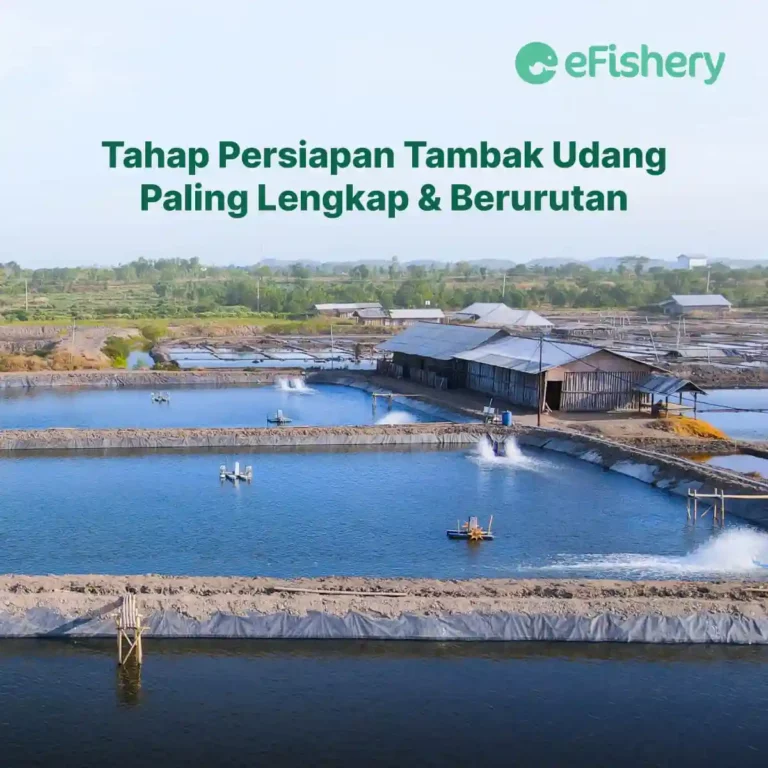Artikel Ini Telah Direview Oleh:

Syavin Pristiwayuning
Penulis Makalah Ilmiah Perikanan
When going to run shrimp farming or enter a cycle change, of course the farmer will prepare the shrimp pond. This aims to support the formation of an ecosystem that is conducive to the maintenance of shrimp during one cultivation cycle.
Preparation of shrimp ponds includes several important steps, if one of the steps is missed, it is possible that the health of the shrimp being cultivated will be disrupted. Therefore, see the preparation stage for the vannamei shrimp cultivation container below!
Vaname Shrimp Cultivation Preparation Stage
Many people want to start vannamei shrimp farming, but some novice farmers may not know where to start. Because, in doing shrimp farming, you cannot do it carelessly.
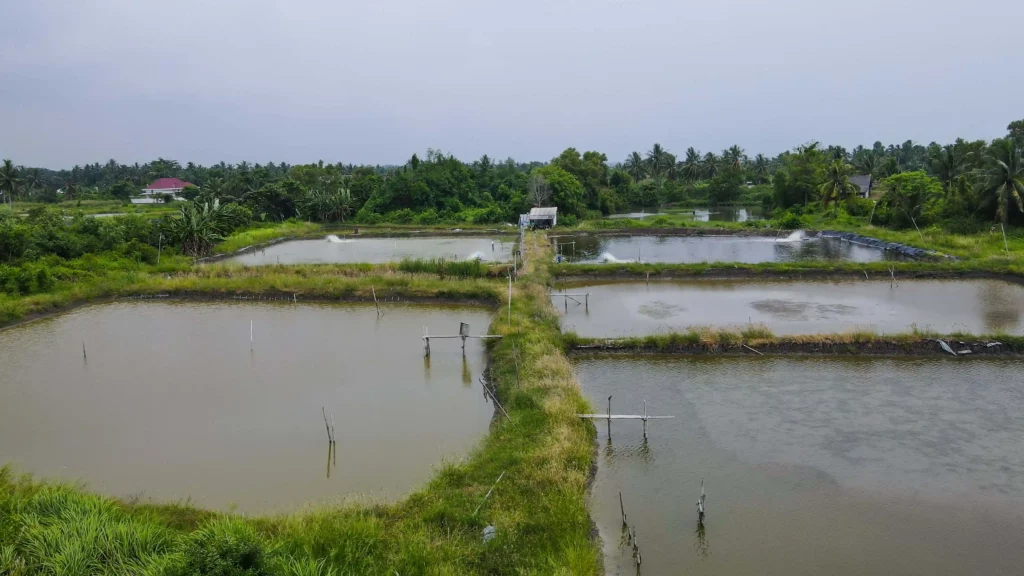
You need to pay attention to important things in preparing for shrimp farming before starting. Come on, look at the stages of preparing for vannamei shrimp cultivation in sequential versions eFishery below this!
1. Preparation of Human Resources
In shrimp farming, you need to prepare competent Human Resources (HR). HR is one of the main components in the success of vannamei shrimp farming. Human resources in shrimp ponds have their respective expertise in their fields. With the right human resources, it can help you in developing a shrimp farming business.
The following are HR tasks in vannamei shrimp cultivation, including:
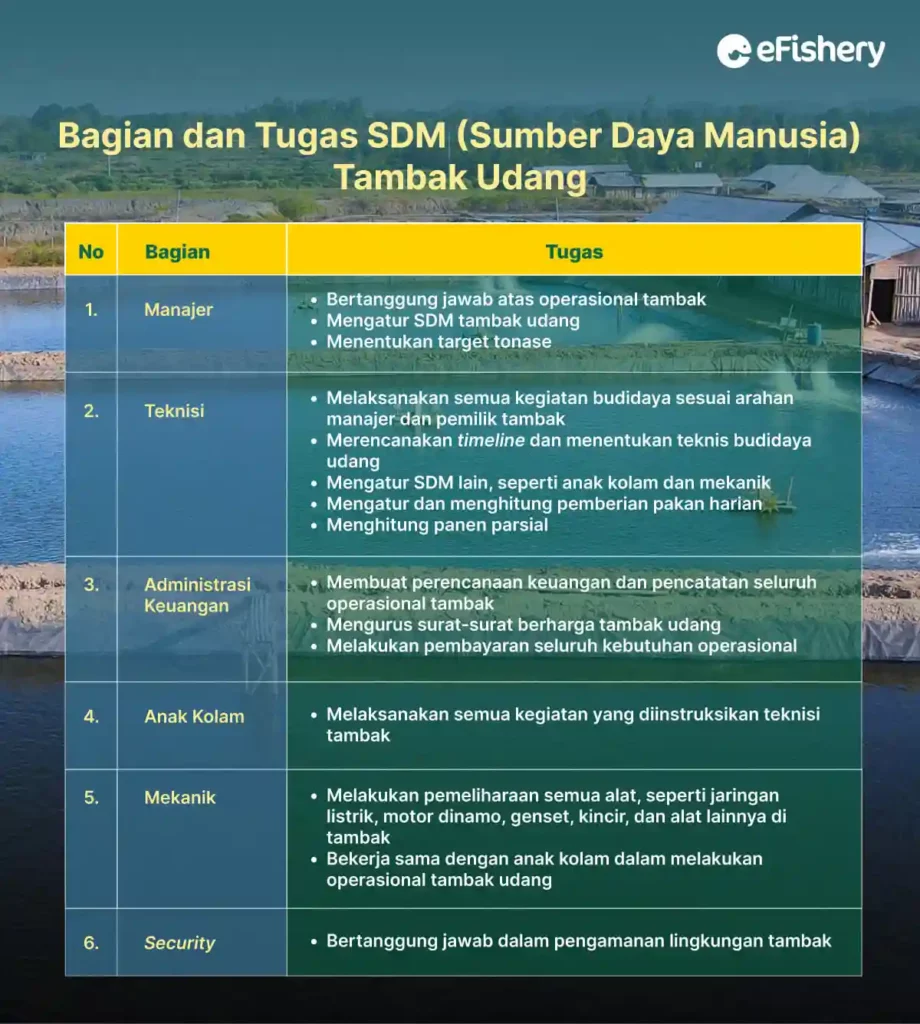
2. Checking Pool Facilities
In vannamei shrimp farming, you need to check the pool facilities. Each pond must have complete facilities with good conditions. Therefore, the Farmers must check all the facilities needed by the pond. You need to ensure that all facilities are complete and ready for use before the cultivation cycle begins.
3. Preparation of Ponds and Laboratory Equipment
In preparing the shrimp pond, you need to check the pond equipment and make sure everything is up to standard. Some of the pond equipment that needs to be prepared to support cultivation activities are as follows:
a. Water Quality Equipment
- Secchi Disk, to measure the brightness of the water
- DO Meter, to measure the dissolved oxygen content in water
- pH Meter, to measure the pH of water
- Refractometer, to measure salinity
- TDS Meter, to measure the value of total dissolved solids
- Thermometer, to measure temperature
- Chemical Parameter Test Kit (ammonia, ammonium, nitrite, nitrate, phosphate, and alkalinity)
- Sample Bottle
b. Anco
Anco is a tool used by farmers to monitor the appetite of cultivated shrimp. The number of anco used in the pond is adjusted to the needs. Usually, Farmers use 2-4 anco placed on the pond. The following is the recommended number of anco based on the area of the pond:
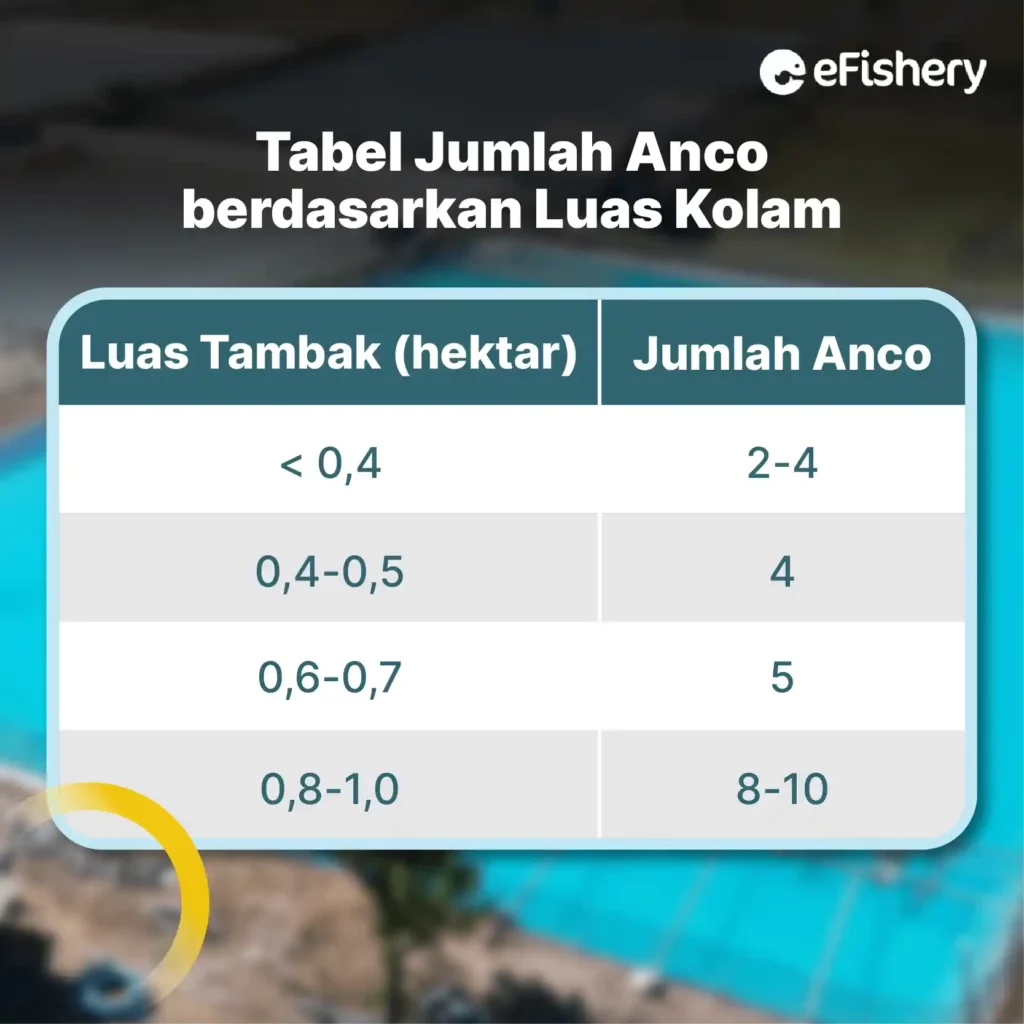
c. Aerator or Waterwheel
Aerator or waterwheel is very necessary for shrimp farming. The water wheel functions to maintain the condition of dissolved oxygen in the water, controlling dirt and mud so that it goes towards central drain or discharge, preventing water quality stratification, maximizing feeding area, as well as reducing the dead corner area or dead zone (low oxygen area).
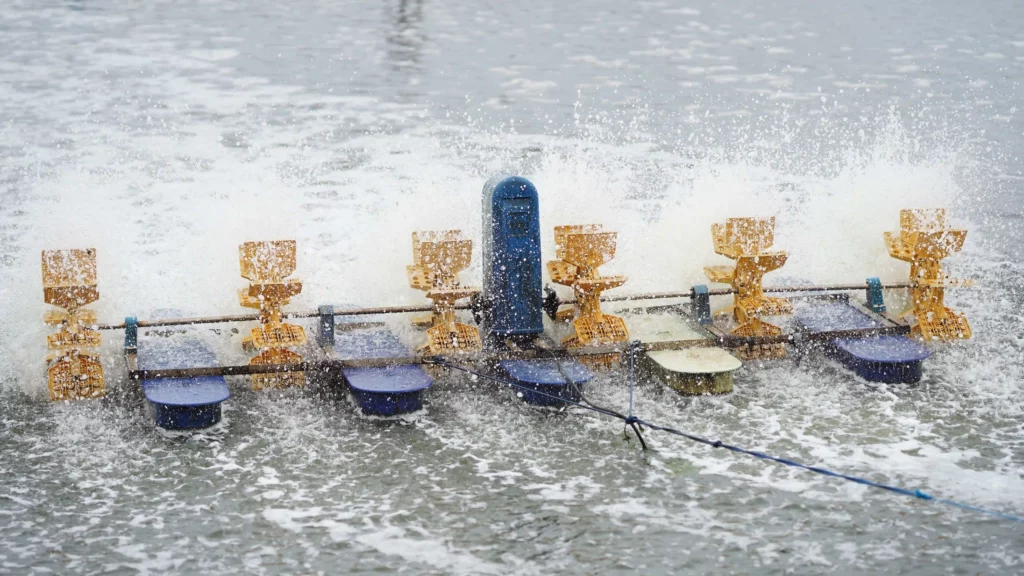
You can adjust the number and power of the wheels according to the area of the pond and the number of shrimp stocked, generally 1 HP wheel can cover up to 400-450 kg of shrimp biomass.
You can adjust the layout of a good water wheel on your pond according to the shape of the pond and its area. The most important function of the wheel is to move the mud towards central drain. The rotation of the fan on the water wheel is expected to produce a flow of water that can evenly distribute the oxygen in the pond water vertically and horizontally.
d. eFeeder 5 from eFishery
eFeeders 5 for shrimp from eFishery is an automatic feeding machine that is able to reduce FCR numbers and is able to increase the size of shrimp optimally. eFeeders 5 connected to the eFeeder application so that you can easily adjust the frequency, dosage, and schedule of feeding shrimp from cellphone Ladies and gentlemen.
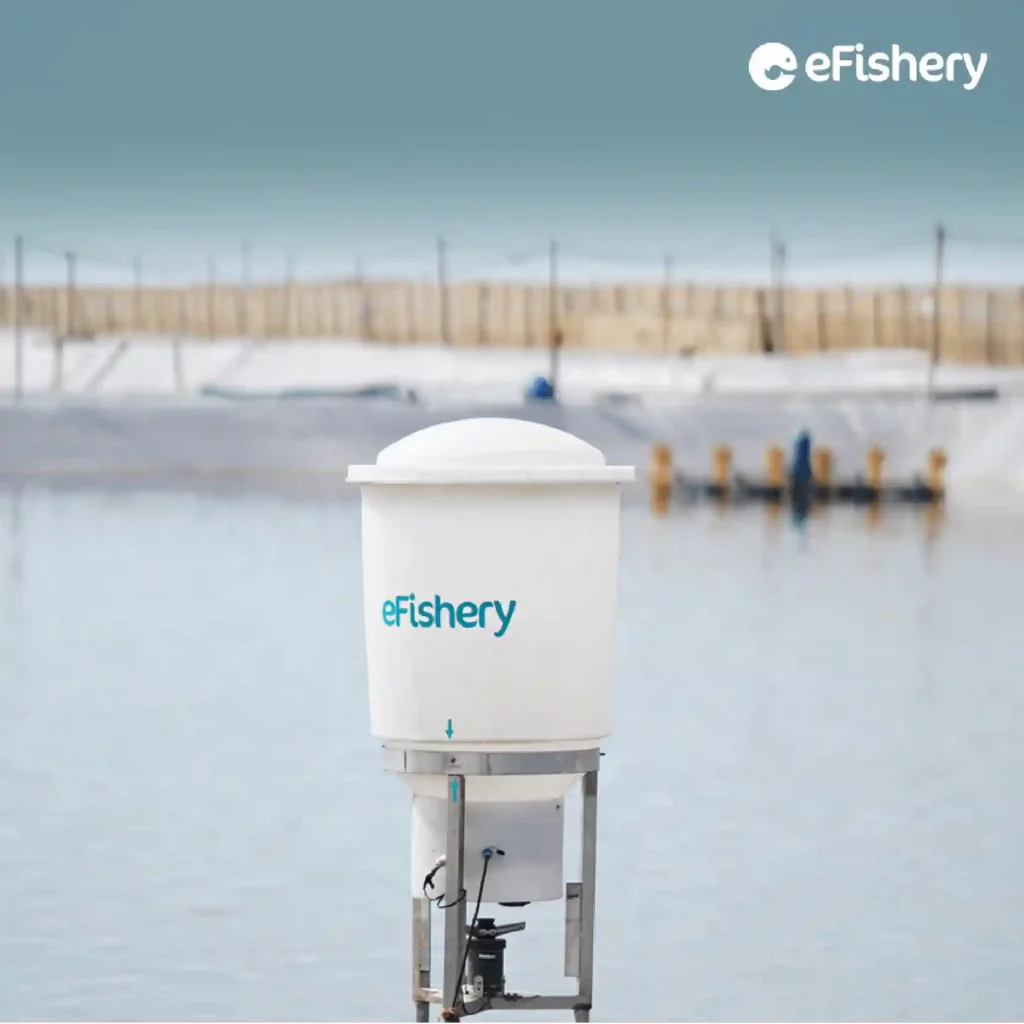
4. Setup Biosecurity
Biosecurity is one of the right preventive measures to overcome cultivation problems. By applying biosecurity, You can minimize the risk of disease transmission in shrimp ponds.
To minimize the risk of disease transmission in ponds, you need to apply examples biosecurity in shrimp ponds:
- Before entering the pond or using the tools used for cultivation, you need to sanitize or sterilize using potassium permanganate.
- Make sure the fry that will be stocked are SPF certified (Specific Pathogen Free) or shrimp fry have been proven to be free from pathogens or other shrimp diseases.
- Make sure the tools used in each pool are different. For example, if you use secchi disk, try to have each pool secchi disk each. However, if a tool needs to be used for all pools, such as a pH meter, then you need to sanitize it first by cleaning it with fresh water before using the tool for a different pool.
- Treat pond water properly and correctly, this is useful for killing pathogens in water. One example is by adding chlorine to the water holding ponds before the water is flowed into the plots.
- Clean the water holding pond from moss, mud and other impurities.
- Use probiotics to prevent the growth of disease-causing bacteria.
- Do a water test to the nearest laboratory to check whether the water quality refers to SNI. In addition, testing serves to find out whether the water is contaminated with disease or not.
- Limit access to vehicles and guests who want to enter the pond area. This is done to anticipate and avoid the spread of diseases that might be carried over.
- Handle solid and liquid waste in accordance with the quality standards for waste water, before disposing of it into the waters. This is so that shrimp farming waste does not harm the pond and the surrounding environment.
- Make sure no pests enter the cultivation environment, such as birds, goats, cats, dogs and other animals that have a risk of carrying disease. For handling birds can use Bird Scaring Device (BSD) to prevent birds from entering the pond.
5. Cleaning
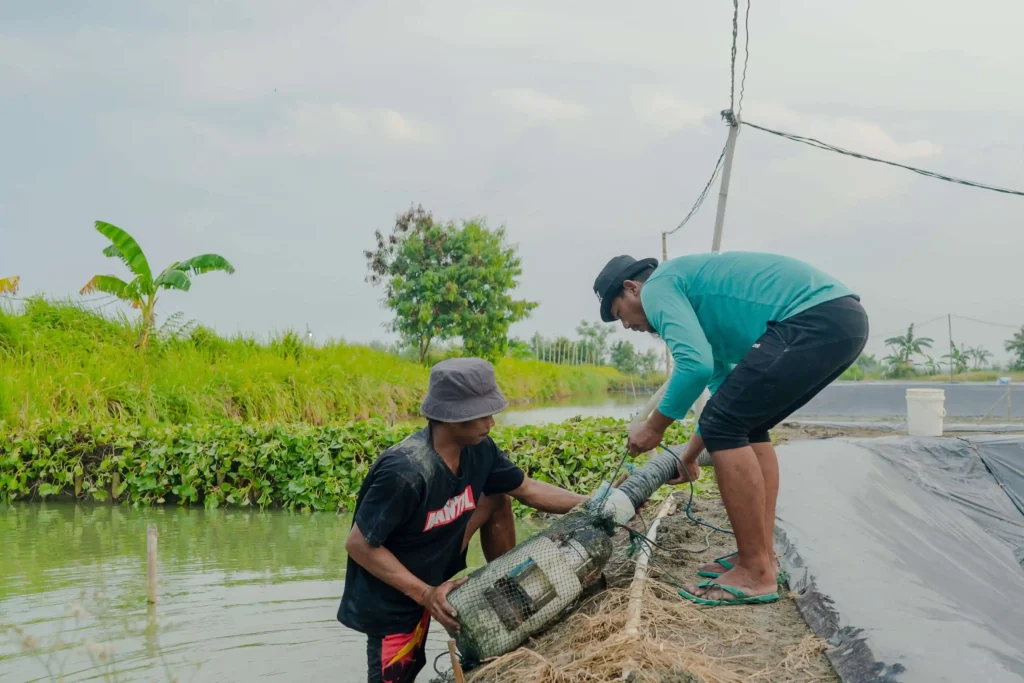
In the pond cleaning stage, there are two cleaning methods that can be carried out, namely the dry method and the wet method.
- Dry Method
Cleaning shrimp ponds with the dry method is done by utilizing sunlight to dry them. The trick is to drain and let the shrimp ponds be in the sun for 10-30 days.
Furthermore, the waste that is at the bottom of the pond is cleaned and disposed of in a predetermined place. However, this dry method cannot be applied in all parts of the pond, so it must be cleaned using the wet method.
- Wet Method
The wet method is carried out in areas of vannamei shrimp ponds which cannot be completely drained. This method is carried out by spraying high-pressure water to remove residual waste from cultivation in the previous cycle.
The wet method has an advantage in terms of time when compared to the dry method, because the wet method only requires a short time so it is more effective and efficient.
6. Drying
Pond drying functions to kill harmful bacteria in pond ponds that have accumulated from previous cultivation activities. After the pond is drained, you need to ensure that the harmful bacteria in the pond have disappeared and died.
There are several things that need to be considered when carrying out the process of drying and drying shrimp ponds, including:
- If the pond has a drain gate, open the floodgate to drain the water.
- If the pond doesn't have a sluice, drain it using a pump.
- Make sure the dirt in the pool dissolves when you throw away the water.
- If there is still dirt left, spray water on the part where there is still dirt so that the pool is really clean.
- After there is no residual water and dirt, close the floodgate again.
- Dry and dry the pool in the sun.
7. Liming
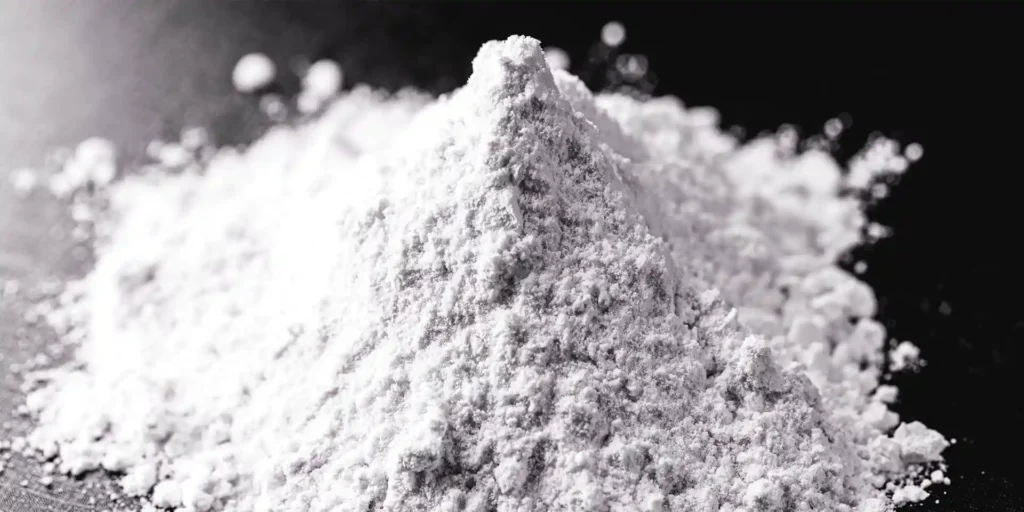
After the vannamei shrimp ponds are drained, the pond must be filled with water and left overnight before rinsing to remove residual waste and increase pH. This process must be continuously repeated until the pH of the water is alkaline in the range of 7-8.5. Under alkaline conditions, the decomposition of organic matter can take place better.
When the pH of the water reaches 7, liming can be done. The type of lime used in this process is CaCO lime3 or dolomite [CaMg(CO3)2] for pool water with a pH close to neutral. Meanwhile, for water pH below 5, you can use hydrated lime [Ca(OH)2] or activated lime (CaO).
Applying lime sowing in ponds can increase the pH of the water and also as a nutrient for plankton. Not only that, liming can eradicate pests in ponds. The success of controlling pests and diseases is an important factor in increasing shrimp production.
You need to pay attention to the amount of lime used. This is because to avoid too high a water pH, which can increase ammonia toxicity and result in death in shrimp. During the calcification process, lime must be spread over the entire pond bottom to the top of the embankment.
Here are the doses of liming in pond ponds:
- pH < 4 using lime as much as 500-1000 kg/ha.
- pH 5-6 using lime as much as 250-500 kg/ha.
- pH> 6 using lime as much as 100-250 kg/ha.
8. Water Filling
After you make sure that the cultivation pond has no leaks or holes, you can fill it with water. You can fill water up to a height of 100 cm with a salinity above 15 ppt.
9. Sterilization
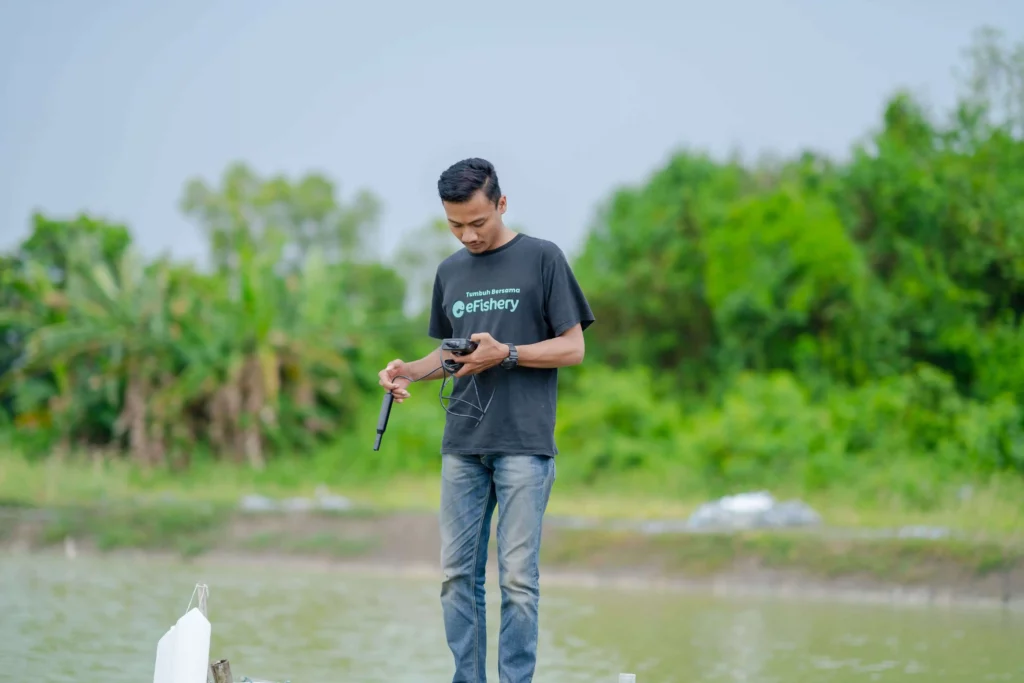
In shrimp farming, you can sterilize using cupric sulfate and saponins. Cupric sulfate is commonly used as a disinfectant to control parasitic and fungal infections, prevent live lichens, and prevent barnacles or small clams from growing. The saponins are used to control the presence of pests such as wild fish which are feared to become shrimp predators as well as pests carrier disease.
Sterilization functions to kill all organisms in the water so as not to endanger the fry. Generally, sterilization takes 5-7 days. In sterilization, you need to pay attention to several things, such as:
- Sterilization is carried out by considering the organisms in the shrimp ponds.
- Sterilization is carried out by paying attention to the instructions for using the product and the threats that may occur.
- Sterilization is carried out using drugs that are environmentally friendly and have no residue.
- The dosage of the drug used must be in accordance with the needs of sterilization
10. Formation of Water
Formation of water in ponds is very important to do to create an ideal pond environment. The formation of water serves to grow plankton in ponds, where the plankton can be natural food for shrimp.
The formation of water is done by spreading the appropriate and appropriate fertilizer. The trick is to dissolve the fertilizer into the water, then you can evenly sprinkle the fertilizer throughout the pond. Furthermore, you can leave the pond for 7-14 days before adding the shrimp fry.
Need Help Regarding Shrimp Cultivation Business?
Fill in your personal data in the following form. Our team will immediately contact you via the number cellphone attached. Make sure the data entered is correct.
Learn Precise and Accurate Steps for Cultivation Preparation at eFarm!
In addition to information regarding the precise and accurate steps in preparing for shrimp farming above, there is still further information about preparing for cultivation in the application eFarm.
eFarm equipped with various features, incl Learn Cultivation which can be accessed free of charge. With this feature, Farmers can watch videos on various aspects of cultivation, from managing shrimp farming capital, feed management, team building or HR for pond maintenance, to how to deal with epidemic diseases.
All videos are brought by experienced shrimp farming experts and farmers, so that the information you get is more accurate and can help maximize shrimp farming.
come on, downloads eFarm and take advantage of features Learn Cultivation for free!

Syavin Pristiwayuning - Penulis Makalah Ilmiah Perikanan
Berpengalaman sebagai asisten koordinator pelatihan teknisi pada tahun 2020 dan saat ini aktif sebagai Technical Support Online di eFishery
Questions Regarding the Preparation of Shrimp Ponds
Things that need to be done in the preparation of a version of a shrimp pond eFishery, such as preparing Human Resources (HR), checking pond facilities, preparing pond and laboratory equipment, preparing biosecurity, cleaning, drying, liming, filling water, sterilizing, and forming water.
- Akmal Y, Humairani R, Mandasari, Muliari, and Zulfahmi. 2020. Application of Closed System Technology to Vaname Shrimp (Litopenaeus vannamei) Farmers of the “Sea Mina Cultivation” Bireuen Group, Aceh. Solma's Journal. 9(2): 249:260
- Rejeki S, Susilowati I, Agustin TW, Ariyanti RW, and Widowati LL. 2021. Science and Technology Program for UNDIP Fostered Villages Production of Ponds Affected by Abrasion with the Application of Leisa and IMTA. Jurna Pasopati. 3(1): 11-17
- Sari H. Pond Preparation Techniques for Growing Vaname Shrimp (Litopenaeus vannamei) in Mitra CP Intensive Ponds. Prima pasuruan, East Java. Thesis. Aquaculture Study Program. Pangkajene Islands State Agricultural Polytechnic. 28 p.
- Untara LM, Agus M, and Pranggono H. 2018. Study of Vaname Shrimp (Litopenaeus vannamei) Cultivation Techniques in Tegal State SUPM Busmetik Ponds with Tuvami Ponds 16 Pekalongan University. PENA Journal of Aquatics. 17(1)- 76-88.
